Zoom
Trash

Implementing a High Performance Work System « Brown Consulting Group Blog. Posted by Eric Brown in Human Resources (HR), Strategy.
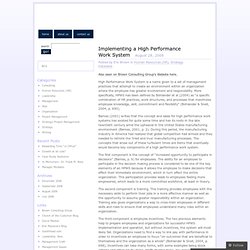
Trackback Also seen on Brown Consulting Group’s Website here. High Performance Work System is a name given to a set of management practices that attempt to create an environment within an organization where the employee has greater involvement and responsibility. More specifically, HPWS has been defined by Bohlander et al (2004) as “a specific combination of HR practices, work structures, and processes that maximizes employee knowledge, skill, commitment and flexibility” (Bohlander & Snell, 2004, p. 690).
Barnes (2001) writes that the concept and ideas for high performance work systems has existed for quite some time and has its roots in the late twentieth century amid the upheaval in the United States manufacturing environment (Barnes, 2001, p. 2). The first component is the concept of “increased opportunity to participate in decisions” (Barnes, p. 9) for employees. The second component is training. References: Barnes, W. Reverse logistics. When a manufacturer's product normally moves through the supply chain network, it is to reach the distributor or customer.
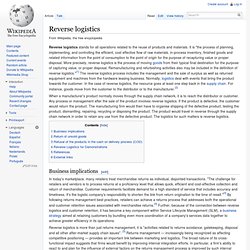
Any process or management after the sale of the product involves reverse logistics. If the product is defective, the customer would return the product. The manufacturing firm would then have to organise shipping of the defective product, testing the product, dismantling, repairing, recycling or disposing the product. The product would travel in reverse through the supply chain network in order to retain any use from the defective product. The logistics for such matters is reverse logistics.
The Focused Factory...{Strategos} What Is A Focused Factory A Focused Factory strives for a narrow range of products, customers and processes.
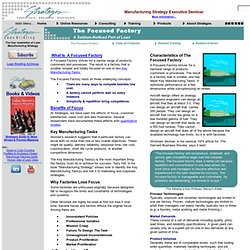
The result is a factory that is smaller, simpler and totally focused on one or two Key Manufacturing Tasks. The Focused Factory rests on three underlying concepts: There are many ways to compete besides low cost. A factory cannot perform well on every measure. The Key Manufacturing Task...{Strategos} The Key Manufacturing Task provides the focus in Focused Factories.
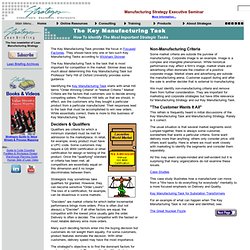
They should have only one or two such Key Manufacturing Tasks according to Wickham Skinner. The Key Manufacturing Task is the task that is most important for competition in the market. Skinner does say much about determining this Key Manufacturing Task but Professor Terry Hill of Oxford University provides some guidance. Lean Business Specialists - Nestadt Consulting. Continual improvement process. A continual improvement process, also often called a continuous improvement process (abbreviated as CIP or CI), is an ongoing effort to improve products, services, or processes.
These efforts can seek "incremental" improvement over time or "breakthrough" improvement all at once.[1] Delivery (customer valued) processes are constantly evaluated and improved in the light of their efficiency, effectiveness and flexibility. Some see CIPs as a meta-process for most management systems (such as business process management, quality management, project management, and program management).
W. Inventory. Inventory or stock refers to the goods and materials that a business holds for the ultimate purpose of resale (or repair).
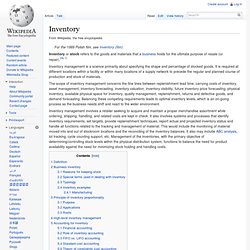
[nb 1] Inventory management is a science primarily about specifying the shape and percentage of stocked goods. It is required at different locations within a facility or within many locations of a supply network to precede the regular and planned course of production and stock of materials. The scope of inventory management concerns the fine lines between replenishment lead time, carrying costs of inventory, asset management, inventory forecasting, inventory valuation, inventory visibility, future inventory price forecasting, physical inventory, available physical space for inventory, quality management, replenishment, returns and defective goods, and demand forecasting. Balancing these competing requirements leads to optimal inventory levels, which is an on-going process as the business needs shift and react to the wider environment. Core competency. A core competency is a concept in management theory originally advocated by two business authors, C.
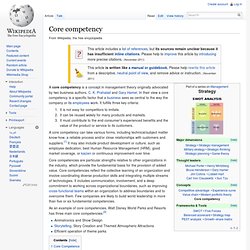
K. Prahalad and Gary Hamel. In their view a core competency is a specific factor that a business sees as central to the way the company or its employees work. It fulfills three key criteria: It is not easy for competitors to imitate.It can be reused widely for many products and markets.It must contribute to the end consumer's experienced benefits and the value of the product or service to its customers. A core competency can take various forms, including technical/subject matter know-how, a reliable process and/or close relationships with customers and suppliers.[1] It may also include product development or culture, such as employee dedication, best Human Resource Management (HRM), good market coverage, or kaizen or continuous improvement over time.
Purchasing management. Purchasing is the function of buying Goods & Services from External Source to an Organisation.Purchase department buys Raw Materials, Spare parts, services etc. as Required by the company or Organisation.Purchase management is One of the most Crucial Area of the Entire Organisation.
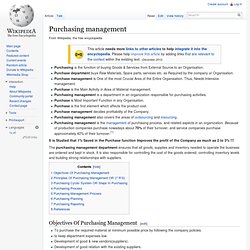
Vendor-managed inventory. Vendor-managed inventory (VMI) is a family of business models in which the buyer of a product (business) provides certain information to a vendor (supply chain) supplier of that product and the supplier takes full responsibility for maintaining an agreed inventory of the material, usually at the buyer's consumption location (usually a store).
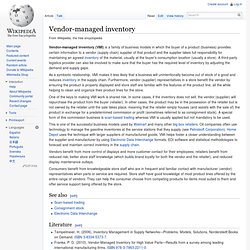
A third-party logistics provider can also be involved to make sure that the buyer has the required level of inventory by adjusting the demand and supply gaps. As a symbiotic relationship, VMI makes it less likely that a business will unintentionally become out of stock of a good and reduces inventory in the supply chain. Furthermore, vendor (supplier) representatives in a store benefit the vendor by ensuring the product is properly displayed and store staff are familiar with the features of the product line, all the while helping to clean and organize their product lines for the store. One of the keys to making VMI work is shared risk. Operational risk management.
The term Operational Risk Management (ORM) is defined as a continual cyclic process which includes risk assessment, risk decision making, and implementation of risk controls, which results in acceptance, mitigation, or avoidance of risk.
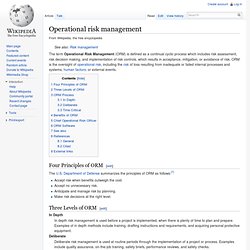
ORM is the oversight of operational risk, including the risk of loss resulting from inadequate or failed internal processes and systems; human factors; or external events. Four Principles of ORM[edit] The U.S. Operational risk. An operational risk is defined as a risk incurred by an organisation's internal activities.
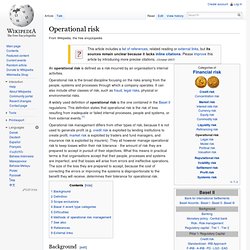
Risk management. Risk management is the identification, assessment, and prioritization of risks (defined in ISO 31000 as the effect of uncertainty on objectives) followed by coordinated and economical application of resources to minimize, monitor, and control the probability and/or impact of unfortunate events[1] or to maximize the realization of opportunities. The strategies to manage threats (uncertainties with negative consequences) typically include transferring the threat to another party, avoiding the threat, reducing the negative effect or probability of the threat, or even accepting some or all of the potential or actual consequences of a particular threat, and the opposites for opportunities (uncertain future states with benefits).
Introduction[edit] A widely used vocabulary for risk management is defined by ISO Guide 73, "Risk management. Job shop. Job shops are typically small manufacturing systems that handle job production, that is, custom/bespoke or semi-custom/bespoke manufacturing processes such as small to medium-size customer orders or batch jobs. Job shops typically move on to different jobs (possibly with different customers) when each job is completed. In job shops machines are aggregated in shops by the nature of skills and technological processes involved, each shop therefore may contain different machines, which gives this production system processing flexibility, since jobs are not necessarily constrained to a single machine. Batch processing. Batch processing is the execution of a series of programs ("jobs") on a computer without manual intervention. Benefits[edit] Batch processing has these benefits: History[edit] Batch processing has been associated with mainframe computers since the earliest days of electronic computing in the 1950s.
There were a variety of reasons why batch processing dominated early computing. Batch processing is still pervasive in mainframe computing, but practically all types of computers are now capable of at least some batch processing, even if only for "housekeeping" tasks. Modern systems[edit] Despite their long history, batch applications are still critical in most organizations in large part because many common business processes are amenable to batch processing. Scripting languages became popular as they evolved along with batch processing. Vertical integration. A diagram illustrating vertical integration and contrasting it with horizontal integration Vertical integration is one method of avoiding the hold-up problem.
A monopoly produced through vertical integration is called a vertical monopoly. Nineteenth-century steel tycoon Andrew Carnegie's example in the use of vertical integration[1] led others to use the system to promote financial growth and efficiency in their businesses. Three types[edit] Vertical integration is the degree to which a firm owns its upstream suppliers and its downstream buyers. Muda (Japanese term) Total quality management. Total quality management (TQM) consists of organization-wide efforts to install and make permanent a climate in which an organization continuously improves its ability to deliver high-quality products and services to customers. While there is no widely agreed-upon approach, TQM efforts typically draw heavily on the previously-developed tools and techniques of quality control. TQM enjoyed widespread attention during the late 1980s and early 1990s before being overshadowed by ISO 9000, Lean manufacturing, and Six Sigma. Production leveling. On a production line, as in any process,[2] fluctuations in performance increase waste.
This is because equipment, workers, inventory and all other elements required for production must always be prepared for peak production. Just in time (business) Cellular manufacturing. 8 Dimensions of Quality. By Chris Akins of Trident-Consulting LLC. Order Winners & Order Qualifiers. 1570100606013.png (3679×1311) Capability and Maturity - Hayes and Wheelwright's Four Stages. Link Manufacturing Process and Product Life Cycles. Summary by Christina Thayer Master of Accountancy Program University of South Florida, Fall 2004 PLC Main Page | Strategy Related Main Page | Structure and Restructure Main Page. Industrial Organization I/O Model of Above-Average Returns. Resource-based view. Hypercompetition. Hypercompetition is rapid and dynamic competition characterized by unsustainable advantage. Flexibility (engineering) Flexibility is used as an attribute of various types of systems.
In the field of engineering systems design, it refers to designs that can adapt when external changes occur. Porter five forces analysis. SWOT analysis. Schonberger World Class Manufacturing. Project planning. Project plan. Make-or-Buy Business Decision - wikiCFO. Supply chain. Lean manufacturing. Supply chain management. Collaborative planning, forecasting, and replenishment.